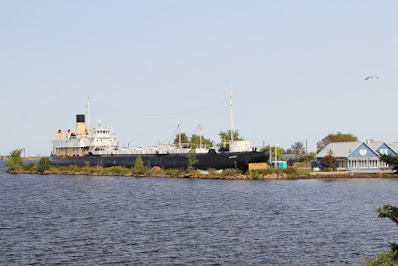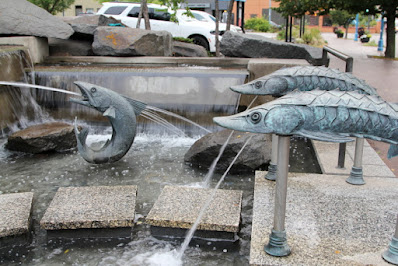Big Manitou Falls on the Black River are the highest waterfalls in Wisconsin with a 165-foot vertical drop, making it the fourth tallest waterfall east of the Rocky Mountains. The falls are located in Pattison State Park, which was named for Martin Pattison.
In his youth, Pattison started working for a lumber company along the Black River and by age 25 he was a full partner. He sold his interest in the lumber company and started purchasing lands in Minnesota that could be used for mining iron ore. He eventually became the largest individual holders of iron ore lands in Minnesota. When he learned that there were plans to build a hydroelectric dam on the Black River that would have destroyed Manitou Falls, he purchase all of the lands along the river below Big Manitou Falls to stop construction of the dam.
The S.S. Meteor is the World's Last Existing Whaleback Ship and is being preserved as a museum on Barker's Island in Superior, Wisconsin. Unfortunately, the Meteor was not open for tours the day I stopped at the site.
Between 1888 and 1898, 43 Whaleback ships were built, most of them in Superior. The S.S. Meteor was launched in 1896 to carry iron ore, but later carried grains and automobiles. Then, in 1943 during WW II, the ship was converted to an oil tanker. A sign by the ship states: "As a boy, Franklin D. Roosevelt came to Superior with his father to watch the launching of a whaleback. In his enthusiasm to get a good view, he was swept into the slip by waves. A member of the Superior Fire Department rescued him before he reached deep water."
Broadacre City was a Frank Lloyd Wright urban development concept city that he worked on for most of his life. Student interns working for him at Taliesin made a scale model of the concept city that was first displayed on April 15, 1935, at an Industrial Arts Exposition at the Rockefeller Center in New York City. After the New York exposition, the model was moved to a "New Homes for Old" Federal Housing Administration (FHA) exposition in Pittsburgh. Following various expositions, the model was returned to Wright's studio where he continued to refine his concept until his death in 1959.
A service station in Cloquet, Minnesota, is one of the few Broadacre City concept plans that was ever constructed. The service station is the only one of its kind every built and it is still in use today.
To honor Swedish immigrants that settled in the Cloquet area of Minnesota, a large Dalecarlian Horse replica is on display in front of the Cloquet Chamber of Commerce Building.
Historically, Dalecarlian Horses were hand-carved wooden toys made for children and a symbol of Sweden. Because each horse was hand-carved and painted with a particular design, the distinguishing features made it possible to determine the location where the horse was produced and the painting artist.
In 1887, Erik Erikson moved from Sweden to Stanton County, Nebraska, and started producing Dalecarlian Horses to be sold in the United States. However, the horses did not become popular in the United States until they were shown at the 1939 World's Fair in New York City where they became a popular souvenir.
Hand-carved Dalecarlian Horses are still produced in Sweden and also at the Hemslojd in Lindsborg, Kansas. Because the horses are all hand-carved, no two horses are alike
The earliest reference of a hand-carved wooden horse that was sold in Sweden was in 1623.
Overlooking Lake Superior in Duluth, Minnesota, is a statue of Leif Erikson. A plaque at the base of the statue states: "Discoverer of America in 1000 A.D."
Leif Erikson was the son of Erik the Red, who founded the first Norse settlement in Greenland where Leif was raised. When his father died, Leif became chief of the Greenland settlement.
Leif was an explorer and is thought to be the first European to set foot on the American continent about 500 years before Christopher Columbus arrived in 1492. According to Icelanders' Sagas, in about 1000 A.D., Leif Erikson established a settlement at Vinland, which is interpreted as being North America.
Located in the same park are the Leif Erikson Flower Gardens.
In 1941, Bob Dylan was born Robert Allen Zimmerman in Duluth, Minnesota. His parents rented the second floor of a house at 519 N. 3rd Avenue East, which is still owned by a Bob Dylan fan. When Dylan was six years old, his father contracted polio and his family moved to Hibbing, Minnesota, to be near family. He spent his life in Hibbing until moving away to attend the University of Minnesota in Minneapolis. After his first year in college, he dropped out of school and moved to New York City to be near his idol Wood Guthrie. While in New York City he played at various clubs around Greenwich Village and then became friends with Joan Baez and worked on civil rights issues with her. His first album was released in 1962 and he released his famous song "Blowin' in the Wind" as a single in 1963 and then in the album The Freewheelin' Bob Dylan." Peter, Paul and Mary recorded "Blown' in the Wind" and it became one of their greatest's hits. Dylan went on become one of the most famous recording artist in history. He currently lives in Malibu, California, and performed concerts in Europe during the summer of 2024.
The Historic Duluth Central High School occupies an entire city block and is just a few blocks from Dylan's house on 3rd Avenue. It was constructed in 1892 and has now been converted into apartment units.
The SS William A. Irvin is a large freighter that carried cargo on the Great Lakes from 1937 until 1978. After being removed from active service, the ship was refurbished and is now moored at a dock in the Duluth harbor as a ship museum. Tours of the ship are offered from about middle of May to the mid-September. Since I did not get to tour the ship, I left the ship tour on my bucket list tor a return visit at a future date when the ship is open.
In 1986, the City of Duluth initiated a program to revitalized the Duluth Harbor Waterfront area into an arts community to attract tourist and locals. The City started the revitalization process by commissioning seven major works of art to be incorporated into the Canal Park area. Additional art projects were started along the Downtown Lakewalk that runs for three miles along Lake Superior The harbor area is now one of the major tourist attractions in Duluth with restaurants, boutique shops, and arts people demonstrating their crafts.
I only walked around the major tourist area, but the one exhibit that really caught my attention was a Ten Commandment Monument. I have seen this same designed monument at various locations in my travels around the United States, but I did not ever know the story behind the monuments. I just thought that some great salesman sold the monuments to a lot of different cities. A plaque beside this monument told the interesting story as follows:
"This monument was given to Duluth and displayed in front of City Hall for almost 48 years. It was then removed from public property and put up for auction as a result of a threatened lawsuit by the American Civil Liberties Union of Minnesota. Concerned local citizens rallied but the winning bid came from Celebration Church in Lakeville, MN. They returned the monument to a group of Duluthians who had it placed on private property in 2004."
Also located in the harbor area are a number of historic marine displays, two lights, and the famous Aerial Lift Bridge.


























































